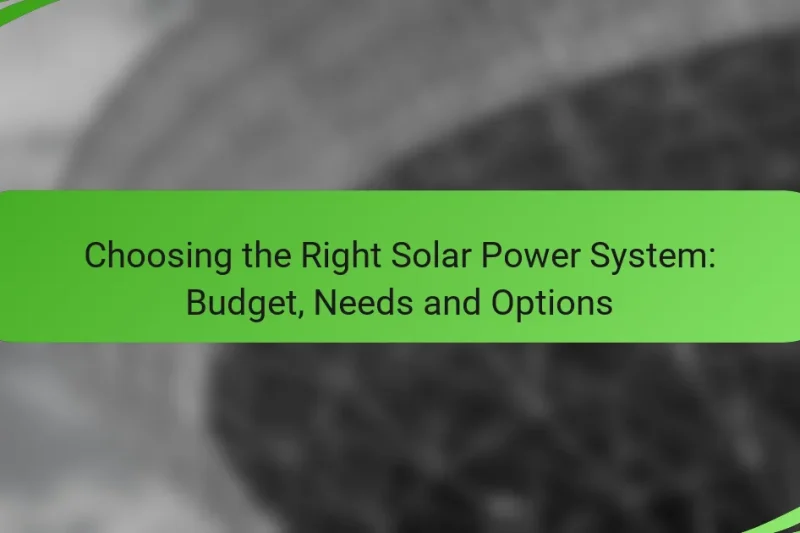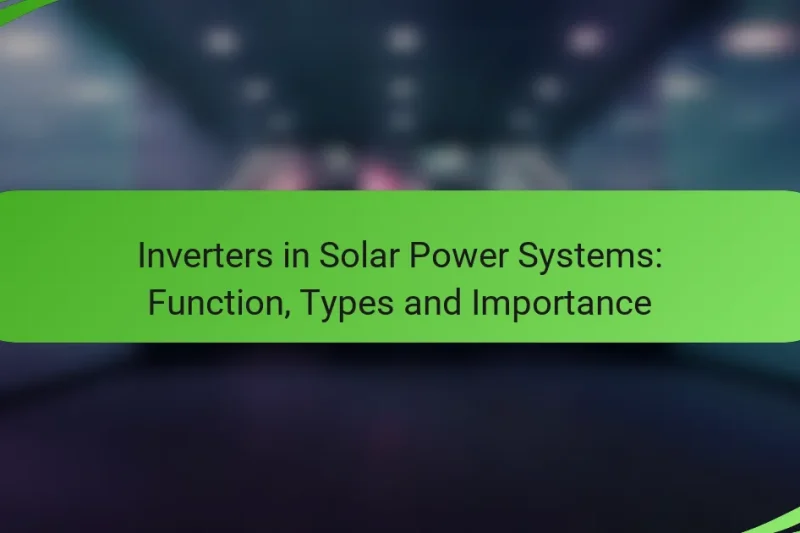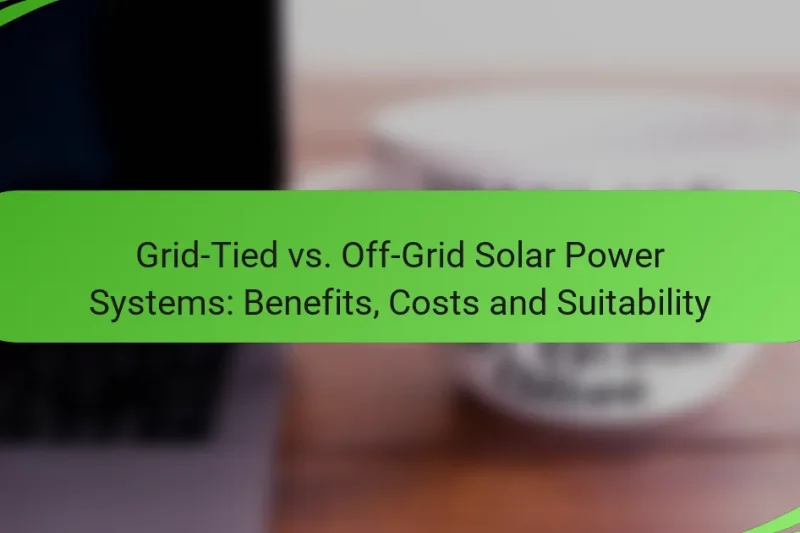Choosing the right solar power system involves understanding your energy needs, budget, and the various options … Choosing the Right Solar Power System: Budget, Needs and OptionsRead more
Types of Solar Power Systems
Solar power systems come in various types, each tailored to meet specific energy requirements and applications. The primary categories include grid-tied, off-grid, hybrid, community solar, and solar water heating systems, each offering unique benefits and functionalities for users.
Best Solar Power Systems for Small Businesses: Efficiency, Cost and Installation
Investing in solar power systems can be a game-changer for small businesses, offering sustainable energy solutions … Best Solar Power Systems for Small Businesses: Efficiency, Cost and InstallationRead more
Inverters in Solar Power Systems: Function, Types and Importance
Inverters play a vital role in solar power systems by converting the direct current (DC) generated … Inverters in Solar Power Systems: Function, Types and ImportanceRead more
Grid-Tied vs. Off-Grid Solar Power Systems: Benefits, Costs and Suitability
When considering solar power systems, homeowners face the choice between grid-tied and off-grid options, each offering … Grid-Tied vs. Off-Grid Solar Power Systems: Benefits, Costs and SuitabilityRead more
Innovative Solar Power Technologies: Trends, Benefits and Applications
Innovative solar power technologies are revolutionizing the energy landscape by improving efficiency, lowering costs, and broadening … Innovative Solar Power Technologies: Trends, Benefits and ApplicationsRead more
Solar Power Battery Storage Options: Capacity, Compatibility and Cost
Exploring solar power battery storage options is essential for maximizing the efficiency of your solar energy … Solar Power Battery Storage Options: Capacity, Compatibility and CostRead more
Monocrystalline vs. Polycrystalline Solar Panels: Performance, Cost and Lifespan
When choosing between monocrystalline and polycrystalline solar panels, it’s essential to consider their performance, cost, and … Monocrystalline vs. Polycrystalline Solar Panels: Performance, Cost and LifespanRead more
What are the types of solar power systems available?
There are several types of solar power systems, each designed for different applications and energy needs. The main categories include grid-tied, off-grid, hybrid, community solar, and solar water heating systems.
Grid-tied solar power systems
Grid-tied solar power systems are connected to the local utility grid, allowing users to draw electricity from the grid when solar production is low. These systems typically include solar panels, an inverter, and a net metering arrangement, which credits users for excess energy fed back into the grid.
One of the main advantages of grid-tied systems is their lower initial cost compared to off-grid systems, as they do not require battery storage. However, they are dependent on the grid’s availability, which can be a drawback during power outages.
Off-grid solar power systems
Off-grid solar power systems operate independently from the utility grid, making them ideal for remote locations or areas with unreliable electricity supply. These systems require solar panels, an inverter, and battery storage to store energy for use when sunlight is not available.
While off-grid systems provide energy independence, they generally have higher upfront costs due to the need for batteries and additional components. Users must also carefully size their systems to ensure adequate energy supply throughout the year.
Hybrid solar power systems
Hybrid solar power systems combine features of both grid-tied and off-grid systems. They can operate connected to the grid while also incorporating battery storage for backup during outages or periods of low sunlight.
This flexibility allows users to maximize their energy savings and maintain power during grid failures. However, hybrid systems can be more complex and costly to install and maintain compared to standard grid-tied systems.
Community solar power systems
Community solar power systems allow multiple users to share the benefits of a single solar installation, typically located in a shared space. Participants can purchase or lease a portion of the solar array, receiving credits on their electricity bills based on the energy produced.
This model is particularly beneficial for those who cannot install solar panels on their own property, such as renters or those with unsuitable roofs. Community solar projects can vary in size and structure, often requiring local regulations and community agreements to be established.
Solar water heating systems
Solar water heating systems use solar energy to heat water for residential or commercial use. These systems typically consist of solar collectors, a storage tank, and a circulation system to move water between the collector and the tank.
They are an efficient way to reduce energy costs for water heating, often providing savings of 50-80% on water heating bills. However, they require adequate sunlight exposure and may need a backup system for cloudy days or high-demand periods.
How do grid-tied solar power systems work?
Grid-tied solar power systems connect directly to the utility grid, allowing homeowners to generate their own electricity while remaining connected to the traditional power supply. These systems use solar panels to convert sunlight into electricity, which can be used immediately or fed back into the grid.
Connection to the utility grid
Grid-tied systems are designed to work in conjunction with the utility grid, meaning they can draw power from the grid when solar production is low, such as during cloudy days or at night. This connection ensures a reliable electricity supply without the need for battery storage, making it a cost-effective option for many homeowners.
When the solar panels produce more electricity than needed, the excess energy is sent back to the grid. This two-way flow of electricity allows for efficient energy use and minimizes waste.
Net metering benefits
Net metering is a billing arrangement that allows homeowners with grid-tied solar systems to receive credits for the excess electricity they send back to the grid. These credits can offset future electricity costs, effectively reducing monthly utility bills.
In many regions, net metering policies allow homeowners to receive compensation at the retail electricity rate, which can significantly enhance the financial benefits of installing solar panels. It’s essential to check local regulations, as net metering policies can vary widely by state or country.
What are the advantages of off-grid solar power systems?
Off-grid solar power systems provide significant benefits, including energy independence and suitability for remote locations. These systems allow users to generate their own electricity without relying on the traditional grid, making them ideal for various applications.
Energy independence
Off-grid solar systems grant users complete control over their energy supply, reducing reliance on external sources. This independence is particularly valuable in areas where electricity costs are high or where power outages are frequent. By generating their own power, homeowners can protect themselves from fluctuating energy prices and ensure a consistent energy supply.
To achieve energy independence, it is essential to size the solar system correctly based on energy needs. Users should evaluate their average daily consumption and consider seasonal variations. Investing in battery storage can further enhance independence by storing excess energy for use during cloudy days or nighttime.
Remote location suitability
Off-grid solar power systems are especially beneficial for remote locations where extending the electrical grid is impractical or too costly. These systems can be deployed in rural areas, cabins, or even on boats, providing a reliable power source without the need for extensive infrastructure.
When considering off-grid solar for remote locations, it’s important to assess local sunlight availability and potential shading from trees or buildings. Users should also factor in the cost of installation and maintenance, which can vary significantly based on location. In many cases, off-grid solar can be more economical than connecting to the grid, especially in hard-to-reach areas.
What factors should you consider when choosing a solar power system?
When selecting a solar power system, consider your energy needs, budget, and local regulations. These factors will help you determine the most suitable system for your home or business, ensuring optimal performance and cost-effectiveness.
Energy needs assessment
Start by evaluating your energy consumption to determine the size of the solar power system you need. Review your utility bills from the past year to identify average monthly usage in kilowatt-hours (kWh). This assessment will guide you in selecting a system that can meet your energy demands efficiently.
Consider factors such as seasonal variations in energy use and any future changes, like adding electric vehicles or home expansions. A well-sized system can significantly reduce your electricity bills and reliance on the grid.
Budget and financing options
Your budget will play a crucial role in choosing a solar power system. Systems can range from a few thousand to tens of thousands of dollars, depending on size and technology. Assess your financial situation and explore various financing options, including cash purchases, loans, and leases.
Look for incentives such as tax credits or rebates that can lower your overall costs. For example, in the U.S., the federal solar tax credit allows you to deduct a percentage of the installation cost from your federal taxes, making solar more affordable.
Local regulations and incentives
Familiarize yourself with local regulations regarding solar installations, as these can vary significantly by location. Some areas may have specific permitting requirements, while others might impose restrictions on system size or placement.
Additionally, investigate local incentives that can help offset installation costs. Many states and municipalities offer programs that provide financial assistance or tax benefits for solar energy systems, which can enhance your return on investment.
What are the emerging trends in solar power systems?
Emerging trends in solar power systems focus on technological advancements, increased energy storage adoption, and integration with smart home systems. These developments enhance efficiency, reliability, and user control over energy consumption.
Advancements in solar technology
Recent advancements in solar technology include improvements in photovoltaic (PV) cell efficiency and the development of bifacial solar panels. These innovations can increase energy output by capturing sunlight from both sides of the panel, potentially boosting efficiency by 10-20% compared to traditional panels.
Additionally, the rise of thin-film solar cells offers flexibility and lightweight options, making solar installations more versatile. These technologies are particularly beneficial for residential and commercial applications where space is limited.
Increased adoption of energy storage solutions
The growing adoption of energy storage solutions, such as lithium-ion batteries, is a significant trend in solar power systems. These batteries allow users to store excess energy generated during the day for use at night or during cloudy periods, enhancing energy independence.
Homeowners can expect to see battery systems that integrate seamlessly with solar installations, providing backup power during outages. The cost of battery storage has been decreasing, making it more accessible for average consumers, with systems ranging from a few thousand to tens of thousands of USD depending on capacity.
Integration with smart home systems
Integration of solar power systems with smart home technologies is becoming increasingly popular. Home automation systems can optimize energy usage by managing when appliances run based on solar generation patterns, leading to cost savings on electricity bills.
Smart inverters and energy management systems allow homeowners to monitor their solar production and consumption in real-time through mobile apps. This connectivity not only enhances user engagement but also enables proactive maintenance and performance optimization of solar systems.






